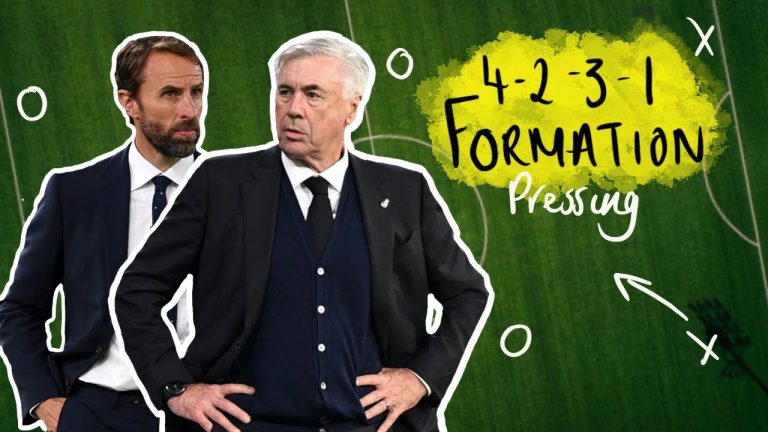In the ever-evolving world of football, teams face the challenge of adapting their pressing strategies to counter different formations. From the traditional 4-4-2 to the modern 4-3-3 or the innovative 3-5-2, each formation presents unique tactical nuances that demand tailored approaches. In this article, we explore the pressing strategies employed by top clubs around the globe, unravelling the secrets behind their success in disrupting the opposition’s play and creating scoring opportunities. Join us as we delve into the intricacies of pressing against different formations and uncover the game-changing tactics that can turn the tide on the pitch.
- Flexibility: One key pressing strategy against different formations is to maintain flexibility in positioning and movement. By adapting to the specific formation of the opposition, teams can effectively press and disrupt their opponents’ build-up play. This involves players constantly adjusting their positioning and pressing angles based on the movements of the opposition players, ensuring that passing lanes are closed down and pressure is applied in the right areas.
- High-intensity pressing: Another effective pressing strategy against different formations is to implement a high-intensity pressing approach. This involves the entire team working together to apply intense pressure on the opposition players, forcing them into making mistakes or hurried passes. By quickly closing down space and applying pressure in numbers, teams can disrupt the opposition’s rhythm and regain possession in advantageous areas of the pitch.
- Targeted pressing: Adjusting pressing strategies based on the specific formation of the opposition is crucial. For example, when facing a formation with a strong defensive midfield, teams may employ targeted pressing by focusing on closing down the opposition’s midfielders and cutting off their passing options. This can disrupt the flow of their build-up play and force turnovers in dangerous areas.
- Counter-pressing: Counter-pressing is another effective pressing strategy against different formations. It involves immediately pressing the opposition players as soon as possession is lost, aiming to win the ball back quickly and prevent the opposition from launching counter-attacks. By quickly regaining possession, teams can maintain control of the game and limit the opposition’s attacking opportunities.
What strategy does the 4-2-3-1 formation employ?
The 4-2-3-1 formation strategy is a highly versatile and effective tactical approach in soccer. This formation consists of a solid back four, two defensive midfielders, three attacking midfielders, and a lone center forward. Its strength lies in its adaptability, as it can easily be shifted into a 4-4-2 or a 4-3-3 formation depending on the team’s needs. Not only does it provide defensive stability with two defensive midfielders, but it also offers great offensive firepower with the three attacking midfielders supporting the lone striker. The 4-2-3-1 formation strikes a perfect balance between defensive solidity and attacking prowess, making it a popular choice among coaches and teams.
What does the term 4 2 2 2 formation refer to?
The 4-2-2-2 formation is a visually balanced and tactically versatile setup in football. This formation features a standard defensive line of four players, providing a strong foundation at the back. The midfield is split into two pairs, with the first pair serving as a double pivot, ensuring solid protection in the central areas just ahead of the defense. The second pair of midfielders operates in a more advanced position, strategically positioned between the lines to provide support for the two centre-forwards. This formation allows for a cohesive defensive structure while also enabling creative attacking movements through the midfield.
What does the 3 5 1 1 formation refer to?
The 3-5-1-1 formation is a tactical approach in football that prioritizes a robust defensive structure. By employing three central defenders and five midfielders, this formation ensures ample coverage and protection for the goal. This defensive setup can prove to be challenging for the opposition, as it becomes arduous for them to penetrate and score goals. The effectiveness of this formation is further enhanced when the full-backs are instructed to stay back and provide additional defensive support.
With its strong emphasis on defensive stability, the 3-5-1-1 formation offers a solid foundation for any team. The three central defenders provide a formidable barrier against the opponents’ attacks, while the five midfielders act as a shield, restricting the opposition’s opportunities. By deploying this formation, teams can effectively limit the scoring chances of their adversaries, making it a popular choice for teams looking to maintain control and secure results.
One key aspect that sets the 3-5-1-1 formation apart is the instruction for full-backs to remain defensive. By staying back and prioritizing defensive duties, the full-backs provide additional cover and support to the central defenders. This tactical adjustment further bolsters the defensive strength of the team, making it even more challenging for the opposition to break through and score goals. The 3-5-1-1 formation thus offers a comprehensive defensive strategy that maximizes defensive solidity and minimizes the opponent’s scoring opportunities.
Unleash Your Tactical Brilliance: Dominate Any Formation
Unleash your tactical brilliance and dominate any formation with our cutting-edge strategies and expert guidance. Whether you’re a seasoned strategist or just starting your journey, our comprehensive approach will equip you with the tools to outsmart your opponents on the battlefield. From analyzing your opponent’s weaknesses to exploiting gaps in their formation, our tactical brilliance course will elevate your game to new heights.
With our unrivaled knowledge and proven techniques, you’ll learn how to adapt to any situation with ease. Gain a deeper understanding of formations, anticipate your opponent’s moves, and make split-second decisions that will leave them stunned. Join us today and unlock the secrets to becoming a true tactician. Unleash your potential and dominate the field like never before.
The Art of Pressing: Cracking the Code of Formations
The power of pressing lies in its ability to disrupt the opponent’s play and create scoring opportunities. It is an art form that requires precision and coordination. Each player must understand their role within the formation and execute it flawlessly. From the moment the whistle blows, the team moves as one, pressing relentlessly, forcing turnovers, and dictating the pace of the game. It is a symphony of movement, a dance of anticipation and aggression. The art of pressing is not just about physicality; it is about intelligence and strategy. It is about cracking the code of formations and unraveling the opponent’s plan. By understanding the intricacies of formations, teams can exploit weaknesses and expose vulnerabilities, ultimately gaining the upper hand in the battle for victory.
In the game of football, formations are like puzzles waiting to be solved. They hold the key to unlocking success on the pitch. The art of pressing is the secret weapon that cracks these codes. It is a strategic approach that disrupts the opponent’s formation, leaving them disoriented and vulnerable. The pressing team acts as a cohesive unit, moving in sync to close down spaces, intercept passes, and force errors. It is a visually captivating display of coordination and teamwork. The art of pressing not only showcases the technical prowess of a team but also their tactical intelligence. It is a relentless pursuit of perfection, a calculated gamble that can turn the tide of a match. In the realm of football formations, the art of pressing is the master key that unlocks victory.
Mastering the Field: Pressing Tactics for Every Formation
Mastering the Field: Pressing Tactics for Every Formation
In the world of soccer, pressing tactics have become an integral part of the game, regardless of the formation a team employs. One effective pressing tactic is the “gegenpress,” popularized by top clubs like Liverpool and Bayern Munich. This high-intensity strategy involves immediately pressing the opponent after losing possession, denying them time to build an attack. By applying this tactic, teams can disrupt their opponents’ rhythm and regain possession quickly, leading to counter-attacking opportunities.
Another pressing tactic that works well with any formation is the “zonal marking.” Instead of man-marking individual players, zonal marking focuses on defending specific areas of the pitch. This allows the team to maintain a compact shape and prevent gaps from opening up. By defending areas rather than players, teams can effectively press and apply pressure collectively, making it harder for the opposition to pass through and create scoring chances.
Additionally, a variation of pressing that suits every formation is the “trigger press.” This tactic involves selectively pressing certain players based on their position or when they receive the ball in specific areas of the pitch. By carefully choosing when and where to press, teams can disrupt their opponents’ passing lanes and force mistakes. The trigger press requires excellent communication and coordination among players, but when executed correctly, it can create turnovers and initiate quick transitions, catching the opposition off guard.
Mastering pressing tactics is essential for any team aspiring to dominate the field, regardless of the formation they employ. Whether it’s the high-intensity gegenpress, the disciplined zonal marking, or the strategic trigger press, these tactics enable teams to regain possession quickly and disrupt their opponents’ game plan. By incorporating these pressing tactics into their training and match strategies, teams can gain a competitive edge and control the flow of the game.
Formations Unraveled: Pressing Techniques for Total Control
Formations Unraveled: Pressing Techniques for Total Control
In the world of football, pressing techniques have emerged as a game-changer for teams striving to maintain total control on the field. By strategically positioning players to press the opposition, teams can disrupt their rhythm, regain possession, and create scoring opportunities. The art of pressing lies in its simplicity: it requires players to seamlessly coordinate their movements to suffocate the opposition’s space. With formations unraveled, teams can unlock the true potential of pressing techniques and dominate the game.
One pressing technique that has gained immense popularity is the “gegenpress.” Originating from German football, this high-intensity pressing style aims to win back the ball immediately after losing possession. Players relentlessly swarm the opposition, denying them time and space to regain control. By implementing this technique, teams can neutralize even the most skillful opponents, leaving them frustrated and struggling to maintain possession.
Another pressing technique that has proven effective is the “zonal press.” In this approach, players form compact zones on the field, cutting off passing lanes and forcing the opposition into making mistakes. By intelligently positioning themselves, players can anticipate the opposition’s moves and intercept passes, leading to valuable turnovers. The zonal press not only ensures total control over the game but also allows teams to launch quick counter-attacks, catching their opponents off guard.
In conclusion, mastering pressing techniques is the key to total control on the football field. Whether it’s implementing the relentless “gegenpress” or the strategic “zonal press,” teams can disrupt their opposition’s rhythm, regain possession, and dictate the flow of the game. By unraveling the formations and integrating pressing techniques seamlessly, teams can dominate their opponents and achieve unparalleled success.
In the ever-evolving world of football, the ability to adapt and strategize against different formations has become a pressing concern for teams. By employing a combination of tactical analysis, player positioning, and effective communication, teams can successfully neutralize their opponents’ strengths and exploit their weaknesses. The key lies in a cohesive and well-executed game plan that maximizes the strengths of the team while minimizing the impact of the opposition. With careful planning and meticulous execution, teams can confidently navigate the complexities of different formations and emerge victorious on the pitch.



